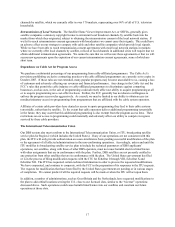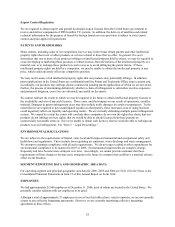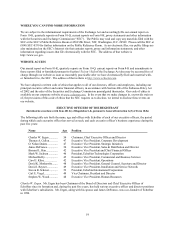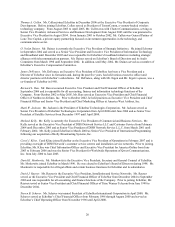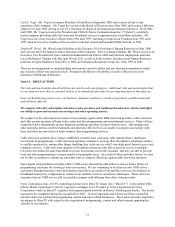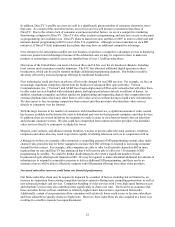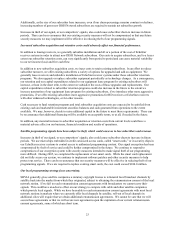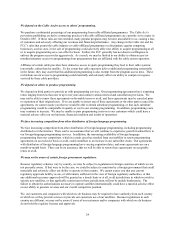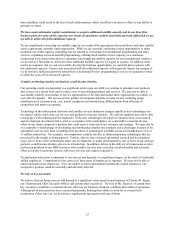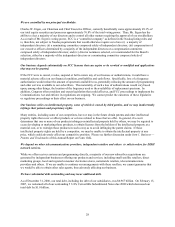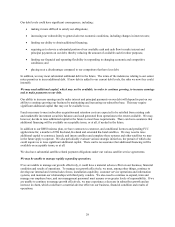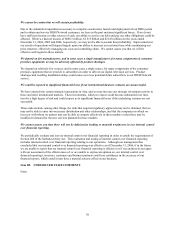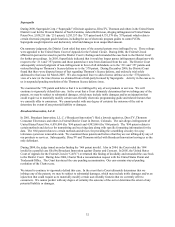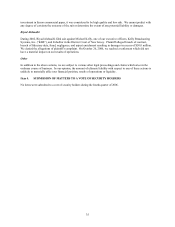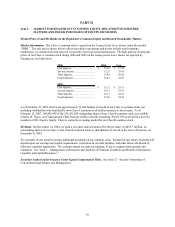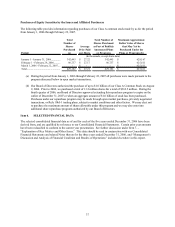Dish Network 2006 Annual Report Download - page 37
Download and view the complete annual report
Please find page 37 of the 2006 Dish Network annual report below. You can navigate through the pages in the report by either clicking on the pages listed below, or by using the keyword search tool below to find specific information within the annual report.27
those deadlines could result in the loss of such authorizations, which would have an adverse effect on our ability to
generate revenues.
We have made substantial capital commitments to acquire additional satellite capacity and do not have firm
business plans for some of this capacity; our results of operations could be materially adversely affected if we are
not able to utilize all of this additional capacity.
We are significantly increasing our satellite capacity as a result of the agreements discussed above and other satellite
service agreements currently under negotiation. While we are currently evaluating various opportunities to make
profitable use of this capacity (including, but not limited to, increasing our international programming and other
services, expanding our local and HD programming, offering fixed satellite service capacity on a wholesale
commercial basis (rather than direct to consumers) and supplying satellite capacity for new international ventures),
we do not have firm plans to utilize all of the additional satellite capacity we expect to acquire. In addition, there
can be no assurance that we can successfully develop the business opportunities we currently plan to pursue with
this additional capacity. Future costs associated with this additional capacity will negatively impact our margins if
we do not have sufficient growth in subscribers or in demand for new programming or services to generate revenue
to offset the costs of this increased capacity.
Complex technology used in our business could become obsolete.
Our operating results are dependent to a significant extent upon our ability to continue to introduce new products
and services on a timely basis and to reduce costs of our existing products and services. We may not be able to
successfully identify new product or service opportunities or develop and market these opportunities in a timely or
cost-effective manner. The success of new product development depends on many factors, including proper
identification of customer need, cost, timely completion and introduction, differentiation from offerings of
competitors and market acceptance.
Technology in the subscription television and satellite services industries changes rapidly as new technologies are
developed, which could cause our services and products to become obsolete. We and our suppliers may not be able
to keep pace with technological developments. If the new technologies on which we intend to focus our research
and development investments fail to achieve acceptance in the marketplace, we could suffer a material adverse
effect on our future competitive position that could cause a reduction in our revenues and earnings. We may also be
at a competitive disadvantage in developing and introducing complex new products and technologies because of the
substantial costs we may incur in making these products or technologies available across our installed base of over
13 million subscribers. For example, our competitors could be the first to obtain proprietary technologies that are
perceived by the market as being superior. Further, after we have incurred substantial research and development
costs, one or more of the technologies under our development, or under development by one or more of our strategic
partners, could become obsolete prior to its introduction. In addition, delays in the delivery of components or other
unforeseen problems in our DBS system or other satellite services may occur that could materially and adversely
affect our ability to generate revenue, offer new services and remain competitive.
Technological innovation is important to our success and depends, to a significant degree, on the work of technically
skilled employees. Competition for the services of these types of employees is vigorous. We may not be able to
attract and retain these employees. If we are unable to attract and maintain technically skilled employees, our
competitive position could be materially and adversely affected.
We rely on key personnel.
We believe that our future success will depend to a significant extent upon the performance of Charles W. Ergen,
our Chairman and Chief Executive Officer and certain other executives. The loss of Mr. Ergen or of certain other
key executives could have a material adverse effect on our business, financial condition and results of operations.
Although all of our executives have executed agreements limiting their ability to work for or consult with
competitors if they leave us, we do not have employment agreements with any of them.


